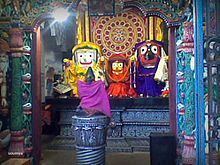 | ||
The damned sanctum sanctorum
The Latin phrase sanctum sanctorum is a Latin translation of the biblical term "Holy of Holies" which generally refers in Latin texts to the holiest place of the Tabernacle of Ancient Israel and later the Temples in Jerusalem, but also has some derivative use in application to imitations of the Tabernacle in church architecture.
Contents
- The damned sanctum sanctorum
- Use of the term in modern languages
- German Catholic processions
- The enclosed house of Hindu temple architecture
- References
The Latin word sanctum is the neuter form of the adjective "holy," and sanctorum its genitive plural. Thus the term sanctum sanctorum literally means "the holy [place/thing] of the holy [places/things]," replicating in Latin the Hebrew construction for the superlative, with the intended meaning "the most holy [place/thing]."
The plural form sancta sanctorum is also used, arguably as a synecdoche referring to the holy relics contained in the sanctuary. The Vulgate translation of the Bible uses Sancta sanctorum for the Holy of Holies. Hence the derivative usage to denote the Sancta Sanctorum chapel in the complex of St John Lateran, Rome.
Use of the term in modern languages
The Latin word sanctum may be used in English, following Latin, for "a holy place," or a sanctuary, as in the novel Jane Eyre (1848) which refers to "the sanctum of school room."
Romance languages tend to use the form sancta sanctorum, treating it as masculine and singular. E.g., the Spanish dictionary of the Real Academia Española admits sanctasanctórum (without the space and with an accent) as a derivative Spanish noun denoting both the Holy of Holies in the Temple in Jerusalem, any secluded and mysterious place, and something that a person holds in the highest esteem.
German Catholic processions
Some regional branches of the Catholic Church, e. g. Germans, are wont to refer to the Blessed Sacrament, when adored in the tabernacle or in exposition or procession (e. g. on Corpus Christi), as the Holy of Holies. By custom, It is adored with genuflection; with a double genuflection, that is a short moment of kneeling on both knees, if in exposition; in the procession this ritual may be nonrigoristically alleviated, but at least a simple genuflection is appropriate when It is elevated by the priest for blessing or immediately after transsubstantiation. Personnel in uniform — which in Germany includes student corporations — give the military salute when passing by or in the moment of elevation.
The "enclosed house" of Hindu temple architecture
The garbhagriha in Hindu temple architecture (a shrine inside a temple complex where the main deity is installed in a separate building by itself inside the complex) has also been compared to a "sanctum sanctorum" in texts on Hindu temple architecture, though the Sanskrit term actually means "enclosed house" or "the deep interior of the house". However, some Indian English authors seem to have translated the Sanskrit term literally as "womb house".
